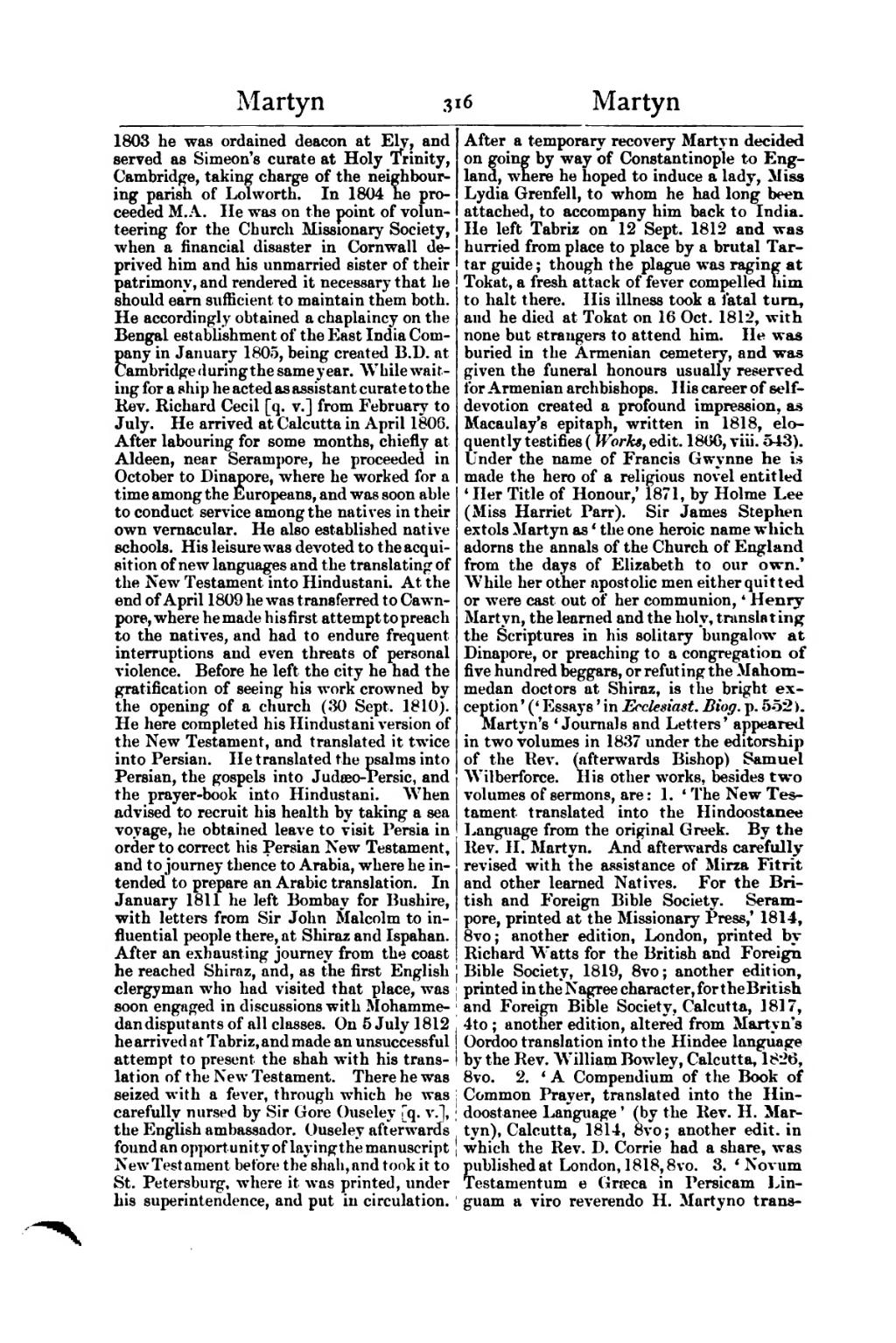1803 he was ordained deacon at Ely, and served as Simeon's curate at Holy Trinity, Cambridge, taking charge of the neighbouring parish of Lol worth. In 1804 he proceeded M. A. He was on the point of volunteering for the Church Missionary Society, when a financial disaster in Cornwall deprived him and his unmarried sister of their patrimony, and rendered it necessary that he should earn sufficient to maintain them both. He accordingly obtained a chaplaincy on the Bengal establishment of the East India Company in January 1805, being created B.D. at Cambridge during the same year. While waiting for a ship he acted as assistant curate to the Rev. Richard Cecil [q. v.] from February to July. He arrived at Calcutta in April 1806. After labouring for some months, chiefly at Aldeen, near Serampore, he proceeded in October to Dinapore, where he worked for a time among the Europeans, and was soon able to conduct service among the natives in their own vernacular. He also established native schools. His leisure was devoted to the acquisition of new languages and the translating of the New Testament into Hindustani. At the end of April 1809 he was transferred to Cawnpore, where he made his first attempt to preach to the natives, and had to endure frequent interruptions and even threats of personal violence. Before he left the city he had the gratification of seeing his work crowned by the opening of a church (30 Sept. 1810). He here completed his Hindustani version of the New Testament, and translated it twice into Persian. He translated the psalms into Persian, the gospels into Judoeo-Persic, and the prayer-book into Hindustani. When advised to recruit his health by taking a sea voyage, he obtained leave to visit Persia in order to correct his Persian New Testament, and to journey thence to Arabia, where he intended to prepare an Arabic translation. In January 1811 he left Bombay for Bushire, with letters from Sir John Malcolm to influential people there, at Shiraz and Ispahan. After an exhausting journey from the coast he reached Shiraz, and, as the first English clergyman who had visited that place, was soon engaged in discussions with Mohammedan disputants of all classes. On 5 July 1812 he arrived at Tabriz, and made an unsuccessful attempt to present the shah with his translation of the New Testament. There he was seized with a fever, through which he was carefully nursed by Sir Gore Ouseley [q. v.], the English ambassador. Ouseley afterwards found an opportunity of laying the manuscript New Testament before the shah, and took it to St. Petersburg, where it was printed, under his superintendence, and put in circulation. After a temporary recovery Martyn decided on going by way of Constantinople to England, where he hoped to induce a lady, Miss Lydia Grenfell, to whom he had long been attached, to accompany him back to India. He left Tabriz on 12 Sept. 1812 and was hurried from place to place by a brutal Tartar guide ; though the plague was raging at Tokat, a fresh attack of fever compelled him to halt there. His illness took a fatal turn, and he died at Tokat on 16 Oct. 1812, with none but strangers to attend him. He was buried in the Armenian cemetery, and was given the funeral honours usually reserved for Armenian archbishops. His career of self-devotion created a profound impression, as Macaulay's epitaph, written in 1818, eloquently testifies (Works, edit. 180G, viii. 543). Under the name of Francis Gwynne he is made the hero of a religious novel entitled 'Her Title of Honour,' 1871, by Holme Lee (Miss Harriet Parr). Sir James Stephen extols Martyn as ' the one heroic name which adorns the annals of the Church of England from the days of Elizabeth to our own.' While her other apostolic men either quitted or were cast out of her communion, 'Henry-Martyn, the learned and the holy, translating the Scriptures in his solitary bungalow at Dinapore, or preaching to a congregation of five hundred beggars, or refuting the Mahommedan doctors at Shiraz, is the bright exception 'Essays' in Ecclesiast. Biog. p. 552). Martyn's 'Journals and Letters' appeared in two volumes in 1837 under the editorship of the Rev. (afterwards Bishop) Samuel Wilberforce. His other works, besides two volumes of sermons, are : 1. 'The New Testament translated into the Hindoostanee Language from the original Greek. By the Rev. II. Martyn. And afterwards carefully revised with the assistance of Mirza Fitrit and other learned Natives. For the British and Foreign Bible Society. Serampore, printed at the Missionary Press,' 1814, 8vo; another edition, London, printed by Richard Watts for the British and Foreign Bible Society, 1819, 8vo; another edition, printed in the Nagree character, for the British and Foreign Bible Society, Calcutta, 1817, 4to ; another edition, altered from Martyn's Oordoo translation into the Hindee language by the Rev. William Bowley, Calcutta, 1826, 8vo. 2. 'A Compendium of the Book of Common Prayer, translated into the Hindoostanee Language' (by the Rev. H. Martyn), Calcutta, 1814, 8vo; another edit, in which the Rev. D. Corrie had a share, was published at London, 1818, 8vo. 3. 'Novum Testament urn e Græca in Persicam Linguam a viro reverendo H. Martyno trans-
Page:Dictionary of National Biography volume 36.djvu/322
Jump to navigation
Jump to search
This page needs to be proofread.
Martyn
316
Martyn
